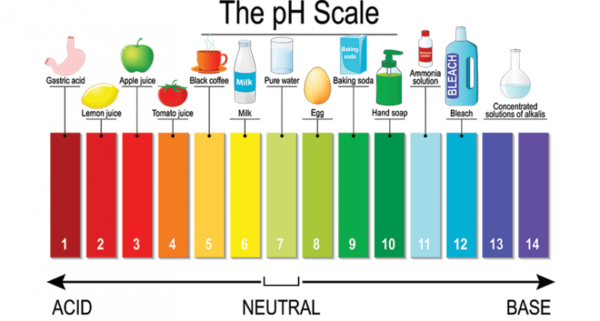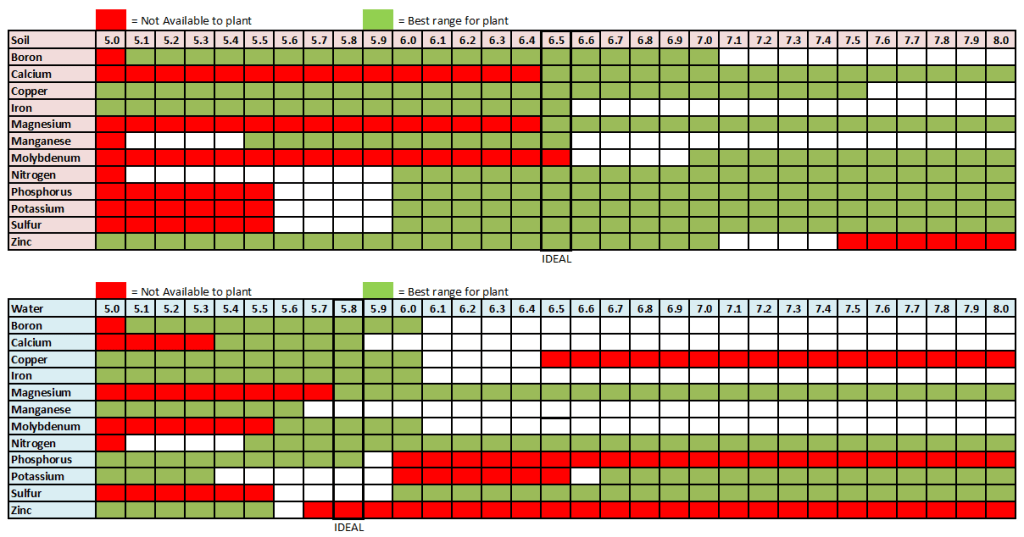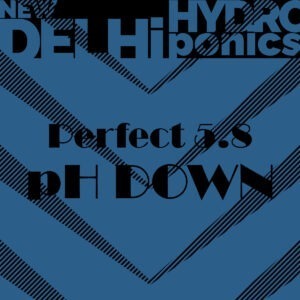To put it simply, pH is the measure of how acidic or basic a solution is. It is calculated on a scale from 1 – 14. A pH value of less than 7 is acidic. Meanwhile, an environment with pH more than 7 is known to be basic. Only absolutely pure water has a pH of 7, also known as pH neutral.
Different minerals are available to the plant in varying degrees at different pH levels. This is the reason why it essential to monitor the pH of your nutrient solution. At certain pH levels, certain minerals become unavailable to the plants.

As water normally has a neutral pH, mixing with chemicals and nutrients causes the water environment to turn either acidic or basic. So pH is a crucial indicator of how the water has been changed chemically. Each mineral has a specific tolerance to a respective pH level. Tap water available to us will usually be a little basic, with a pH of between 7-8, adding nutrients to this water will often bring down the pH a little (Truly depends on the composition of the nutrients).
Normally, main macronutrients (i.e Nitrogen, phosphorus and potassium etc) are hard to move in a too high, or too low pH environment. That makes it difficult for plants to absorb them, which results in deficiencies. Meanwhile, Micro-nutrients (nutrients that are required in small quantities, copper, molybdenum etc.) are usually easily affected at the far end of the pH scales. Too low of pH and micronutrients are so soluble that plants get an excess of these nutrients. This can lead to plant toxicities. Too high of pH, these micronutrients become less mobile and plants’ ability to take up these nutrients is reduced.
Often, the first indicators that pH has gone out of the optimal range are the younger foliage of plants turns a little yellow or pale. Growers can know that plants have failed to get sufficient important nutrients.
What is the ideal pH for plants?
Below is a chart showing nutrient availability at different pH values in both soil and hydro. With ideal ranges marked.

As shown, when pH moves to the both ends, plants’ ability to absorb a number of nutrients is severely affected.
So, in hydroponics, the ideal spot where plants can take up many minerals is in the middle, precisely from 5.5 – 6.5.
This is also the range that is commonly suggested for most hydroponic crops. Soil growing may require a slightly higher pH.
Your job as a grower is to keep your pH balanced in the range recommended. Some growers will set the pH to the lower acceptable end and allow it to drift upwards to the higher acceptable end before adjusting again. This method can help uptake of nutrients such as Magnesium which are better available to the plants at a slightly higher pH value. We find as long as the pH is within bounds and not drifting too much, crop quality remains top notch.
Measure your pH
Our recommended method involves using an electronic pH pen. Plenty budget options to get you started on amazon, but we recommend buying now from Hanna instruments. It’s a bit expensive, but buy once cry once right ? Moreover, sooner rather than later, you will want to upgrade your generic pH pen to something more substantial. None the less, with correct calibration, the cheap pens suffice just fine, and we ourselves use them as a secondary measurement device.
Calibrate! Super essential. You will need a calibration buffer solution. Make it yourself using buffering tabs off amazon and distilled water from your local pharmacy, or get a solution from amazon or hanna instruments. Two point calibration with a lower pH buffer is recommended (usually around pH7 and pH4). Calibrate as often as you can.
Some links below, we do not represent these products in any form.
Amazon.in | Hanna instruments India
Adjust your pH
It is really as simple as adding a pH down solution to you nutrient mix. Our perfect 5.8 pH down formula is manufactured with the highest quality mineral elements and is very concentrated. A little goes a long way. Add 0.25ml of pH down to 1 liter of water and measure pH reduction. Calculate how much pH down you need to get to your desired pH level according to your reservoir size, and boom! Verify again after 1 hour and adjust.
